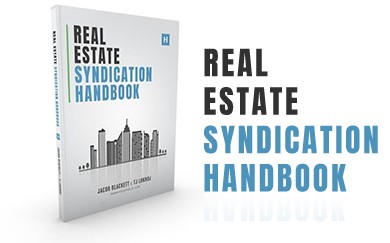Real estate investing never goes out of style. Now more than ever, there are several creative and innovative ways to invest in real estate and make a profit. What are the most viable options? Real estate syndication and multi-family crowdfunding.
Real estate syndication offers you the opportunity to be a passive investor. Here, you give your money to professionals who can invest and pay you a return when due. Although the entire process may look complicated and leave you confused, Holdfolio is on hand to provide you with the perspective you need.
At Holdfolio, we guide our clients through the entire process of investing in real estate syndication. In this comprehensive guide, we’ll explain how you can calculate real estate syndication returns and what returns you can expect from your investment.
Table of Contents
What Is Real Estate Syndication?
As the name suggests, real estate syndication involves investors coming together to pool money to invest in real estate deals. A syndication comes in handy when you’ve reached your investment limit or when you do not have enough capital to fund a new investment deal.
Real estate assets such as mobile homes, self-storage units, apartments, and land are available through real estate syndication.
There are two parties involved in typical real estate syndication deals: the sponsor and the passive investors. Both parties contribute differently to the syndication process.
Who Is a Real Estate Syndicator?
A real estate syndicator, also known as the general partner or the managing member, is responsible for developing the investment strategy, finding investors, negotiating with the seller, and formulating a business plan.
Real estate syndicators execute the due diligence on prospective property acquisitions. They underwrite the deal and arrange the financing. Syndicators typically provide five to twenty percent of the total investment amount with personal funds. The syndicator also receives an “acquisition fee” for seeking out a deal.
Syndicators are often tasked with asset management. They work closely with the property management team and handle investor relations. If property management isn’t outsourced, the syndicator may volunteer to do the job and receive payment via returns. To avoid mishaps, the syndicator must be good at active management to oversee the property effectively.
A syndicator is responsible for the introduction and execution of the entire process from start to finish. At the close of the deal, the syndicator is the one in charge of asset operation. Their main priority is flawlessly executing a business plan and giving passive investors quality returns.
Passive Investor Defined
Passive investors are responsible for financing 80% to 95% of investment capital. These investors can earn passive income through real estate syndications.
As a passive investor, you’ll be eligible for income from the investment either on a monthly or quarterly basis. Also, you’ll receive a return if the property is sold on a predetermined exit strategy.
In addition to great returns, there are tax benefits, appreciation, and equity pay down attached to the investment. The property’s value gradually increases over time, bolstering an investors’ return on investment (ROI). Also, because they own a property, investors receive tax benefits through their K-1 tax filings.
Returns on Real Estate Syndications
For real estate syndications, multi-family properties are the most stable asset class. This stability stems from the fact that folks will always need a place to live. Thus, multi-family deals and apartments will always thrive.
Experienced syndicators look towards properties with the potential to appreciate.
Distribution of returns in real estate syndication always follows pre-agreed terms in the operating contract.
To calculate what returns passive investors should expect to get from a syndication deal, we’re going to be looking at four metrics. These metrics are used to measure the performance of an investment.
Cash on Cash Return
Calculated annually, CoC return is a gauge of your return on investment. To get an accurate figure, you check the cash flow return against your original investment.
Let’s say you invested $200,000 in a syndication deal, you receive $16,000 in distributions at the end of the year. Since $16,000 is 8% of your total investment ($200,000), your CoC (Cash on Cash) return is 8%.
CoC returns are not static as they’re meant to increase yearly during the lifetime of the investment. As the general partner implements the business plan to optimize the property, CoC should average around 8 percent per year.
Equity Multiple
Equity multiple seeks to calculate the cash distributions on a real estate investment. The equity multiple also takes into account the initial investment and compares it to the total equity attached to that property. Simply put, the equity multiple establishes the percentage of investment returns relative to the total capital invested in that structure.
A tad bit similar to the Cash on Cash return metric we’ve just examined, the difference here is that the equity multiple takes into account the total investment value received and divides it by the investment sum total.
To put things into perspective, let’s give a real-world example:
So let’s say that you decided to get a real estate property for $100,000 and after two years, you decide to sell it for twice the amount — $200,000.
If the deal goes through successfully, it has delivered an equity multiple of 2. On the flip side, if you received $150,000, you have an equity multiple of 1.5.
With the equity multiple, investors are often led by impressive values like a 2.5. Regardless of the value, a skilled investor should always consider the timing as most metrics, the equity multiple included, are just projections.
When the projections look too good to be true, it might be time to ask the manager about the property’s track record and if it backs up those numbers or not.
Internal Rate of Return

The internal rate of return calculates how much gain an investment is expected to make annually. It makes the Net Present Value (NPV) of all cash flow equal to zero. Why is the NPV set to zero? To determine the value of annual ROI over time.
If you’re not a math geek, calculating the internal rate of return might be strenuous. Regardless, Excel comes in handy when calculating IRR. All you need to do is type in the IRR and reference the cells. This add-on will calculate your IRR using inputted variables and tell you what percentage of your investment grows annually. For a more detailed explanation on how to go about this you can watch this tutorial.
Preferred Return
Preferred return is also known as a class A share in real estate syndication. Here, the syndicator decides what percentage it’ll be before presenting the deal to investors.
Preferred return usually ranges from 5% to 9% and must be paid out to investors before the syndicator takes his part of the returns. This metric examines the total passive income an investor can expect to make from a deal minus the sales proceeds.
It’s important to note that in real estate syndications, equity is usually split “70/30” or “80/20,” with the more significant bulk going to investors. The remainder (30% or 20%) is the carried interest that belongs to the sponsor. It’s paid from the remaining cash flow after the investors have been paid, and it’s their payment for curating a profitable deal.
How Real Estate Syndications Work
On the surface, real estate syndications appear to be straightforward. However, the process is demanding because of the numerous things that need to be done, like going through due diligence documents and private placement memorandum among other things. Although these tasks might seem overly complex, syndication is similar to other real estate investments. The only difference is that real estate syndications happen on a larger scale.
There are three phases involved in real estate syndications. The bulk of the work is for the syndicator, and from start to finish, they are fully engaged. It falls to the syndicator from sourcing investor capital to the final liquidation. Let’s take a look at the three phases:
The Origination Phase
This phase spans several months and requires a lot of work. At the originating stage, the syndicator locates the perfect property, does due diligence, and works actively to raise funds required for acquisition.
Here, the syndicator does conservative underwriting to determine projected ROI values. They also negotiate the property’s purchase price, conduct a physical inspection, and audits the property’s financial record to ensure nothing is amiss.
At this point, the business plan is formulated alongside several strategies to ensure everything works in the long run.
The Operation Phase
This phase is all about executing the already drawn up business plan. The plan features steps the syndicator intends to take for harnessing the property’s optimal potentials and making high profits.
In the operation phase, the syndicator is responsible for renovations or general repairs, executing rent increases, lease renewals or lease-up plans.
Additionally, they’re charged with collecting rent, property maintenance, leasing out vacant units, paying property tax and insurance, distributing cash flow to investors, and giving reports on the asset’s condition.
The operation phase usually spans over several years, as long as the deal is active. So, till the “beat” stops, activities by the syndicator remain ongoing.
The Liquidation Phase
Investors receive their capital through liquidity. At this stage, the syndicator executes renovation and repairs to make the house attractive to potential buyers.
When these clients come around, the syndicator offers facility tours, prepares financial reports, reviews offers, and negotiates a purchase contract. Once the deal goes through, they’ll give each investor their percentage of the profit.
To enter a real estate syndication, you don’t have to look for other investors and suitable commercial real estate as there’s a service that goes through the hassle for you. With several entities providing this solution, Holdfolio ranks high.
They also accept accredited and non-accredited investors. Without further ado, let’s take a look at the inner workings of Holdfolio.
Investing With Holdfolio: What Does It Entail?

Holdfolio has been in the real estate arena since 2014 and has built a trusted and reputable brand over the years.
While we’re famous for our investment in single-family properties, we offer crowdfunding opportunities for investors. At the moment, we have a budding clientele of over 300 investors.
The minimum investment amount is $20,000. With this amount, you will gain access to mouthwatering investment opportunities and earn a passive annual income without lifting a finger.
Holdfolio also spares you the stress of looking for the right real estate properties. As it stands, Holdfolio manages over 3000 apartment units with an above-average investment return. The current track record? A mind-boggling 19.50% ROI.
Another reason to consider investing with Holdfolio is that we, unlike most other platforms, have offerings tailored to suit non-accredited investors.
Benefits of Real Estate Syndication
Generally speaking, there are many benefits attached to investing as a whole. However, several perks are particular to real estate syndication, including:
- Reduced Risk
The reduced risk-benefit of real estate syndication is a recurring theme as you share risk with other investors on a deal. Since you can invest a minimal amount of money into several projects at once, there’s no risk of losing your money if one project crashes.
Syndication is focused chiefly on multi-family units. Therefore, if a few tenants move, the remaining will cover operational costs.
- Tax Benefits
Investing in real estate syndication deals passes tax deductions down to investors. Now, you can compound your money for years as an equity holder without paying taxes.
- Passive Income
Syndication remains one of the best passive income forms in real estate. Besides initial due diligence on the property, you do not have to do anything except monitor your account balance.
The bulk of the work is left for the sponsor and you’re eligible for returns at the year’s end. It’s an excellent idea if you’re a busy person with money to invest.
- An Inflation Fail-Proof
Inflation is an integral part of every economy. When it happens, it reduces the value of your cash at hand, stocks, and bonds. However, real estate prices tend to increase during inflationary periods, resulting in more profits for the investor.
- Forced Appreciation
The values of multi-family properties are determined by NOI (Net Operating Income). There are two options open to management to increase net operating income.
The first is through rent increment. Expense reduction is the other alternative. When these options are applied by the investor, a “forced appreciation” happens.
- No Danger of Liability Exposure
The two parties involved in a syndicate play different roles. While the management team controls funding and decides how the deal pans out, investors are only concerned with making funds available.
Consequently, investors can never be held responsible for any decision the management team makes. If you are amongst the former group, you won’t be in the line for any lawsuits that may arise.
Real Estate Syndications: Why Exercising Caution Is a Must
While the returns on real estate syndication are often significant and are an excellent way to generate passive annual income, treading with caution before becoming a member is non-negotiable.
For starters, some sponsors lie about projected returns to attract investors. If you’re not adept at reading real estate market cycles, talk to a professional before you make any move. You might want to apply the brakes and check things out once projected returns are above 20%.
The performance of the deal usually varies from the projected returns and that’s normal. However, the difference between both shouldn’t be too significant in the grand scheme of things.
Don’t be afraid to ask questions when you’re unclear about something. You should be able to trust your sponsor with your hard-earned money. When necessary, ask for track records, proof, and do your research.
Major Takeaway
Rather than have your money lie dormant in a savings account, investing it will see your money work for you and bring in annual returns.
Very few investments offer most investors the financial freedom attached to real estate syndications. This investment form grants you unfettered access to deals considered inaccessible in the past.
At Holdfolio, a leading real estate syndication firm, your money is in safe hands. From start to finish, tested and trusted professionals are in charge to ensure you get optimal returns on a yearly basis.
If you’d like to start your real estate syndication journey with us, the adventure begins here!
 Back to Blog
Back to Blog




